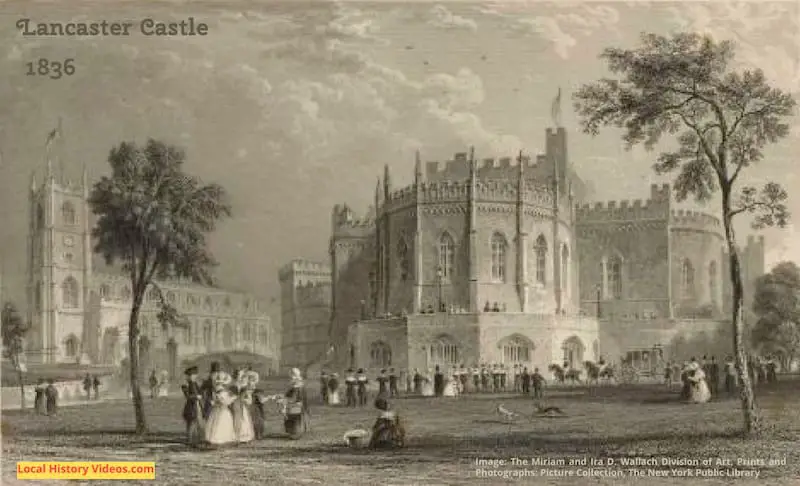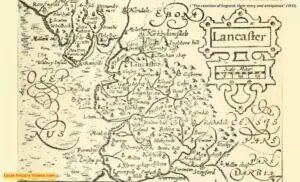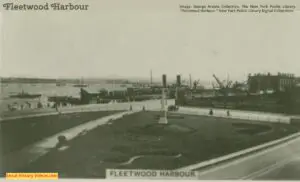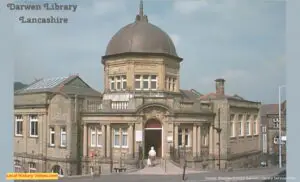Glimpse history through old images of Lancaster, Lancashire, England.
Time Travel
Using old pictures and photos, and photos from the early 2020s of the same location, this video shows what different parts of today’s Lancaster streets used to look like in the past.
Good location titles and date stamps mean you always know where and when you are looking at.
There’s also a clever morph of local old maps, showing how the city and its infrastructure changed over time.
Lancaster: A City Through Time (Then and Now) – The Time Travel Artist on YouTube
Cotton Mill 1946
Silent archive footage shows the women and men working in a cotton mill in Lancaster in 1946.
Cotton Mill (1946) – British Pathé on YouTube
Lancaster Buses
These next five videos are trailers for transportation DVDs you can buy. While they focus on the city’s buses, there are plenty of people, cars, local streets, buildings and businesses and even building sites that also appear.
1989:
LANCASTER BUSES 1989 – DaveSpencer32 on YouTube
1990:
LANCASTER BUSES 1990 – DaveSpencer32 on YouTube
1992:
LANCASTER BUSES 1992 – DaveSpencer32 on YouTube
1993:
LANCASTER BUSES 1993 – DaveSpencer32 on YouTube
2001:
LANCASTER BUSES 2001 – DaveSpencer32 on YouTube
Historic Book
Extract from:
“The History and Antiquities of the Town of Lancaster“, by Robert Simpson
Published 1852
Pages 374 – 376
Chronological Miscellanies
17 November, 1802, a halbert stolen from the Mayor’s door.
15 February, 1803, a vagrant publicly whipped in Lancaster market-place.
2 April, 1803, James Morris, pilloried in Lancaster market-place, for fraud. Found dead in bed next morning, verdict, ” by visitation of God.”
Sunday, 7 August, 1803, first prize brought into Lancaster this war, the French ship polacre, “L’Harmonie,” 238 tons burthen. Cargo, 307 bales cotton; 935 ewts. Campeachy wood; 20 bundles buffalo-hides. She sailed from New Orleans for Marseilles, and was taken 25th July, lat . 35.10, long. 23.16, by the “Paragon,” letter of marque, of Lancaster, Capt. Hart, twenty guns, Messrs. Ridley and Dodson owners.
22 September, 1803, Prince William Frederick of Gloucester visited Lancaster, inspected the Volunteers, entered the Castle, and ascended John O’Gaunt’s chair.
October, 1803, Rev. Mr. White, Vicar of Lancaster, is a prisoner at Fontainbleau.
January Quarter Sessions, 1807, entry made of Cotton and Woollen Mills, employing 3 apprentices and 20 other persons or upwards,
Lonsdale Hundred, three; Amounderness, none; Blackburn, six; Leyland, none; West Derby, none; Salford, thirteen. Total 22.
18 July, 1807, Joshua Newsham pilloried in Lancaster market-place.
Sunday, 21 July, 1811, New Organ in Lancaster Church opened by Mr. Langshaw.
September, 1812, in cutting a drain in Pudding-lane, two small querns, many pieces of earthenware, and some human bones were found.
Memorial of Daniel Eccleston (Lancashire halfpenny by him), in Lancaster Gazette, 21 and 28 December, 1816.
18 July, 1818, the Dungeon Tower of Lancaster Castle just taken down.
4 October, 1818, new burial ground of Lancaster Church consecrated.
Packet Boats started on canal, between Preston and Kendal, 1 May, 1820.
Fare through, 4s. after-cabin ; 6s. fore-cabin. Shorter distances, Id. and 1d. per mile.
October, 1820, only three Friendly Societies in Lancaster: – “The GoodIntent,” 120 members; ” Friendship and Unity,” 68 members; ” Samaritan,” 425 members. Sixty public houses in the town.
Up to 1819 the Corporation lighted the street lamps, but that year, a meeting resolved that each street should light its own; in 1820 the same; but in 1821, many inhabitants refused to subscribe.
Friday, 19 July, 1822, a freestone statue of John o’Gaunt placed in the niche in Gateway Tower; cut by Claud Ninno, a working mason.
February, 1823, roof of Lancaster Church repaired.
Sunday, 12 October, 1823, the maiden peal rung, by the Preston ringers, on the Lancaster church bells.
2 March, 1824, Hannah Clough, a prisoner in Lancaster castle, under process of Ecclesiastical Court, did penance in Lancaster church.
28 September, 1825, at a public meeting in Lancaster, resolved to raise £8000 in £20 shares to light the town with gas.
Whitmonday, 1825, the ” Samaritan ” was the only Friendly Society that walked in procession to church.
11 and 12 September, 1826, 1,300 lbs. of salmon taken in Mr. Bradshaw’s fishery in the Lune.
May, 1826, one of Buonaparte’s generals, with his lady, visited Lancaster castle , and left money which released and set up again in the world a poor debtor, with wife and five children.
Tuesday, 23 May, 1826, Glasson branch of Lancaster canal opened.
June 1826, gas – pipes begun to be laid down in Market-street .
24 February, 1827, first attempt to light Lancaster streets with gas .
The Queen’s Visit
8TH OCTOBER , 1851 .
T he most memorable event of modern times,connected with the history of LANCASTER, is,
undoubtedly, the visit of our beloved Queen to her ancient and loyal town of LANCASTER, the seat of her Duchy, and county town of the Palatinate. It is impossible to describe the feelings of gratitude to her Majesty which pervaded the breasts of all classes, when first it was announced that her most gracious Majesty had kindly promised to visit this town. Every anxiety was evinced to do justice to so kind a condescension.
And preparations were made throughout the whole of the route from the railway-station to the castle, to do honour to the occasion. Warm and universal as were the external demonstrations of loyalty and attachment, no language could describe more correctly the feelings of those who were present, amounting to a “religious awe,” than to say that never was there a time when one and all more fervently implored, on behalf of our most gracious Sovereign Lady Queen Victoria, that our Heavenly Father would “so replenish her with the grace of His HOLY SPIRIT, that she might always incline to His will, and walk in His way; that He would endue her plenteously with heavenly gifts; that He would grant her, in health and wealth, long to live; that He would vanquish and overcome all her enemies; and that finally, after this life, she might attain everlasting joy and felicity, through JESUS CHRIST our Lord.”
Such were the earnest prayers of thousands who beheld her on that occasion, proceeding not from a sense of obligation and duty to our Queen, but the result of ardent affection and devoted attachment to her Royal Person, iterating and reiterating the cry
GOD SAVE OUR QUEEN !







